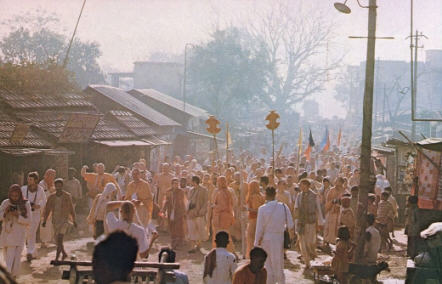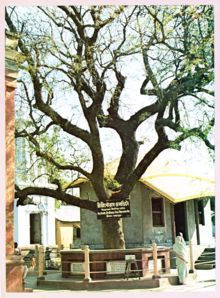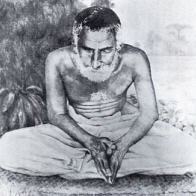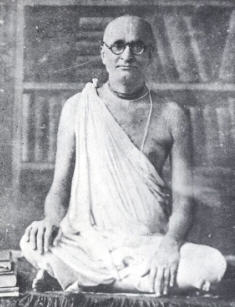His Holiness Brahmananda Svami served for several years as the first president of the first ISKCON temple in the United States (while at the same time working as a teacher in the New York City public school system). He later became director of ISKCON Press and in 1 970 accepted the renounced order of life. He was the first devotee to introduce Krsna consciousness in Africa. He has recently been preaching in Africa and India.

[Lord Caitanya Mahaprabhu, who is Krsna Himself in the form of His own pure devotee, appeared 500 years ago in Bengal, India, to teach by His own example how one can become fully Krsna conscious. The teachings of Lord Caitanya were recorded and transmitted by many faithful disciples, but they were virtually unknown in the West until 1896, when Srila Bhaktivinoda Thakura, a great spiritual master in the disciplic line from Lord Caitanya, published a short book entitled Sri Caitanya Mahaprabhu His Life and Precepts and sent copies to the Western world. The following is the second of three articles depicting the pioneering efforts of Srila Bhaktivinoda Thakura, and those who have followed him, in spreading the great benediction of Krsna consciousness to the West.]
Displaying The Transcendental Energy of Lord Caitanya, Bhaktivinoda Thakura made a startling prophecy, like Lord Caitanya, who had previously predicted the worldwide spread of the chanting of Hare Krsna. In 1885, almost 100 years ago, Bhaktivinoda published an article in his monthly journal, Sajjana-tosani, in which he wrote as follows: "Lord Caitanya did not advent Himself to liberate only a few men of India. Rather, His main objective was to emancipate all living entities of all countries throughout the entire universe and preach the Eternal Religion. Lord Caitanya says in the Caitanya-bhagavata: 'In every town, country and village, My name will be sung.'
"There is no doubt that this unquestionable order will come to pass. In the world now there are so many religious communities, and in their purest mature form they are the religion of singing the praises of the Lord. At the present time there is a great spiritual quest going on in the world, and it seems that one unalloyed religion which is the essence of all the religions will soon emerge. What is that religion? It is plain to see that in western countries and in Asia, religions are engaged in conflicts. There is no doubt that these religions will not be able to endure. Therefore many of the established religions which harbour prejudiced, conflicting beliefs have become fragmented. When all these contradictory dogmas are removed, it is then and there that all religions will be united. Let us consider what specifications the Eternal Religion would have: 1. God is one and is the all-knowing source of knowledge. He is devoid of all limitations and is the reservoir of all qualities. 2. All living entities are infinitesimal parts and parcels of consciousness, and the eternal function of all living entities is to serve the Supreme Lord. 3. To sing the glorious qualities of the Supreme Personality of Godhead and to establish the brotherhood of all men is pure religion.
"Gradually the established religions will then be removed of all specific contradictions, and the secular or 'party spirit' will not remain. Then all castes, all creeds and men of all countries will be united in coexistent brotherhood under the Supreme Personality of Godhead, united by nama-sankirtana." Hari-nama-sankirtana is the congregational chanting of the holy name of the Lord. This congregational chanting was especially taught by Lord Caitanya, by Lord Nityananda, His associate, and by Their devotees, such as Haridasa Thakura and Srivasa Pandita. Thus Srila Bhaktivinoda continues: "Then and there, personal hereditary status will be considered insignificant, and intercaste hatred will disappear, and the common brotherhood of man will never be forgotten. Then we will carry the vessel of the Nectar of Devotion of Haridasa, we will follow the words of Srivasa and smear our bodies with the dust of Their Feet. O Lord Caitanya, Lord Nityananda, the human race will spontaneously dance in ecstasy.
"Very soon the unparalleled path of hari-nama-sankirtana will be propagated all over the world. Already we are seeing the symptoms. Already many Christians have tasted the nectar of divine love of the holy name and are dancing with karatalas [hand cymbals] and mrdangas [drums]. Educated Christians are ordering these instruments and shipping them to England. By the super-excellence of Lord Krsna's holy name and the grace of pure devotees, our consciousness gets purified. After listening to a lecture on these principles, a great gathering of brahmanas danced with drums and karatalas, singing, 'Fill your eyes with the vision of the advent of the Two Holy Brothers [Lord Caitanya and Lord Nityananda].' Even the Salvation Army somehow or other has its form of kirtana. When I see these signs, my hopes of seeing Lord Caitanya's aforesaid prophecy being fulfilled are quickened, and that time has arrived. Although there is still no pure society of Vaisnavas to be had, yet Lord Caitanya's prophetic words will in a few days come true, I am sure. Why not? Nothing is absolutely pure in the beginning. From imperfection, purity will come about.
"Oh, for that day when the fortunate English, French, Russian, German and American people will take up banners, mrdangas and karatalas and raise kirtana through their streets and towns. When will that day come? Oh, for the day when the fair-skinned men from their side will raise up the chanting of jaya sacinandana, jaya sacinandana ki jaya [All Glories to Lord Caitanya! All Glories to Lord Caitanya!] and join with the Bengali devotees. When will that day be? On such a day they will say, 'Our dear Brothers, we have taken shelter of the ocean of Lord Caitanya's Love; kindly embrace us.' When will that day come? That day will witness the holy transcendental ecstasy of the vaisnava-dharma [the eternal occupation of devotional service to the Lord] to be the only dharma [eternal engagement], and all the sects and religions will flow like rivers into the ocean of vaisnava-dharma. When will that day come?"
The Birthplace of the Lord

To usher in this new day of spiritual glory, Bhaktivinoda had founded the Visva Vaisnava Raj Sabha (international Society of Devotees) in 1844. The purpose of this organization was to propagate the teachings of Lord Caitanya through meetings, public discourses, and publication and distribution of literature. Its establishment was an important step in the realization of the Thakura's dream of a society based completely on theistic principles, as described in the Vedic scripture Srimad-Bhagavatam. In previous epochs, Indian culture, social habits and customs were all connected with religion. Art, literature and drama and even marriage customs, diet and people's names were all God-centered. But during Bhaktivinoda's time, the onslaught of atheistic materialism had become so evident that he felt the need for vigorous preaching to radically change the deteriorating mentality of the people. His original motto "Back home, back to Godhead" pointed out his message to the deluded populace of Kali-yuga (the present Age of Quarrel). Bhaktivinoda propagated Lord Caitanya's method of congregational chanting of the holy name, for he was convinced that if only a small number of India's people took Lord Caitanya's teachings to heart, peace and harmony would prevail throughout the world.
To give impetus to the mission of Lord Caitanya, Srila Bhaktivinoda painstakingly searched out Lord Caitanya's birthplace. Until the Thakura's time, the precise location of Caitanya Mahaprabhu's appearance was unknown a fact that indicates how moribund His teachings had become in India. Srila Bhaktivinoda combed old government records and consulted antiquarian maps and authentic books written during the time of Lord Caitanya. Then he took support from the inspired testimony of his spiritual master, Srila Jagannatha dasa Babaji. In Sridhama Mayapur, on the eastern bank of the Ganges, the holy site was finally ascertained. For this Jagannatha dasa Babaji is memorialized by all Vaisnavas:
gauravirbhava-bhumes tvam
nirdesta saj-jana-priyah
vaisnava-sarvabhaumah
sri-jagannathaya te namah
"I offer my respectful obeisances to Jagannatha dasa Babaji, who is respectful to the entire community of devotees and who discovered the place where Lord Caitanya appeared." In this way, Jagannatha dasa Babaji and Bhaktivinoda Thakura followed the example of the six exalted Gosvamis of Vrndavana, who were sent to Vrndavana by Lord Caitanya to uncover the sites of Krsna's pastimes. During the time of Lord Caitanya, Vrndavana was just an open field. By revealing these holy sites, the Gosvamis sparked a renaissance in God consciousness. Similarly, Bhaktivinoda Thakura resurrected the teachings of Lord Caitanya and provided the Krsna consciousness movement with a center from which Mahaprabhu's movement could be broadcast throughout the world.
The Lord Sends Assistance
Now that the great pioneering work had been established, another enlightened personage was needed to carry it on. Bhaktivinoda prayed fervently to Lord Caitanya to send someone. (We are reminded of how, four hundred years earlier, Sri Advaita Prabhu, foreseeing a hellish growth of materialism and irreligion, had similarly prayed for the advent of Lord Caitanya Himself.) Another prophesy was then penned by Thakura Bhaktivinoda: "A personality will soon appear to preach the teachings of Lord Caitanya and move unrestrictedly over the whole world with His message."

On February 6, 1874, while Bhaktivinoda was serving in Puri as manager of the Jagannatha temple, a son was born to him. At the moment of birth, when the infant was taken from his mother, the child's umbilical cord was draped around his neck and across his chest, appearing like the thread brahmanas wear after their initiation. Everyone was very impressed with this sign. During the annual Rathayatra festival, six months later, in July, the massive holy cart in which Lord Jagannatha, a form of Krsna, is pulled by thousands of devotees came to a sudden stop just outside Bhaktivinoda's house. While the crowd was trying to get the cart moving again, Bhaktivinoda's wife took the opportunity to have her new son blessed by Lord Jagannatha. She rushed out of her house with the baby and placed him high on the cart at the lotus feet of the Lord. At that very moment, a huge flower garland worn by Lord Jagannatha fell down, encircling the infant. Bhaktivinoda, overjoyed, then understood that his own son was Lord Caitanya Mahaprabhu's answer to his prayers. That son would later be known as Srila Bhaktisiddhanta Sarasvati Thakura.
As the child grew up, Bhaktivinoda eagerly gave him transcendental instruction. Thus at the age of only seven years, Bhaktisiddhanta Sarasvati Thakura had committed to memory the entire Bhagavad-gita and could even explain the meaning of its verses. Once, the young boy took a mango from the room of the family Deity and ate it. Bhaktivinoda reprimanded his son, explaining that to eat food meant to be offered to the Lord was an offense. Bhaktisiddhanta resolved on the spot never again to eat a mango, and he kept this vow throughout his life, despite the mango's being perhaps the world's most tasty fruit. At the age often, Bhaktivinoda Thakura initiated his son with the Hare Krsna mantra.
As a student, Bhaktisiddhanta Sarasvati distinguished himself in mathematics, history, philosophy and Vedic astronomy. He wrote scholarly articles and treatises, edited two monthly magazines and started a cultural association, as well as a tol, or school, to teach astronomy. He was offered, but declined, a chair at Calcutta University. Throughout this time, he attended and participated in his father's Visva Vaisnava Raj Sabha.
Bhaktivinoda wanted his son to be initiated with the essential Gayatri mantra. Because it is not customary for one's own father to perform this ceremony, he instructed Bhaktisiddhanta to approach Srila Gaurakisora dasa Babaji Maharaja, an important saint of Navadvipa, which is near Sridhama Mayapur: At first Gaurakisora seemed to the young man a very unlikely choice for a spiritual master. He was living an extremely secluded and ascetic life, he had no disciples, and he was even illiterate. So Bhaktisiddhanta apparently did not take his father's instructions to heart. But Bhaktivinoda Thakura could understand that Gaurakisora dasa was a great teacher in the preceptorial disciplic succession. He was renunciation personified (vairagya-murti) and was always merged in the elevated state of spiritual separation from Krsna known as vipralambha. Finally, in 1901, Bhaktisiddhanta Sarasvati Thakura surrendered himself, and Gaurakisora duly accepted him as his only disciple.
In 1911 Bhaktivinoda Thakura was invited to address the All-India conference of Panditas. Unable to attend because of illness, he sent Bhaktisiddhanta Sarasvati to speak in his place. The lecture was entitled "Truth Regarding the Comparitive Position Between a Brahmana and a Vaisnava." It was received as a work of genius and was the highlight of the conference. By 1913 Bhaktisiddhanta had established his first printing press, the Bhagavata Press in Krishnanagar, solely for printing his writings. He then wrote the first of his many famous Bengali commentaries, which include his "Anubhasya" on Sri Caitanya-caritamrta, his "Anuvrtti" on the Upadesamrta, and a commentary on Srimad Bhagavad-gita.
The Mission Begins Expanding

Bhaktisiddhanta Sarasvati Thakura stayed mainly in Mayapur during this time, writing and sometimes giving discourses to the pilgrims who began to visit Lord Caitanya's birthsite. He was respected for his authoritative books and forthright preaching. An important figure in a popular religious organization once approached Bhaktisiddhanta and was so impressed by his purity and potency that he became his disciple. He arranged for Bhaktisiddhanta's transportation to Calcutta, rented a storefront for him, and in many other ways provided Bhaktisiddhanta with good facilities for preaching. Soon many people once again became interested in the teachings of Lord Caitanya.
Bhaktisiddhanta then extended his preaching throughout India, following the example of Lord Caitanya. Lord Caitanya had spread His teachings by dispatching the six Gosvamis north to Vrndavana and Lord Nityananda to West Bengal and had preached Himself in South India and Orissa. Bhaktisiddhanta soon was able to open centers in many cities, such as Calcutta, Bombay, Allahabad, Benares, Bhuvanesvar, Dacca, Hardwar, Madras, New Delhi and Puri. Ultimately, sixty-four such centers were established. The purpose of these centers was to broadcast the teachings of Lord Caitanya, to distribute Bhaktisiddhanta's books and to perform worship of the sri-murti, or form of the Lord, according to the authorized principles of the pancaratra scriptures.
A Fateful Meeting
Like his great father, Bhaktisiddhanta Sarasvati Thakura wanted to promulgate Lord Caitanya's teachings beyond the shores of India. Bhaktivinoda Thakura had determined the course with his book Lord Caitanya His Life and Precepts. The medium of preaching had to be English, rather than Bengali or any other Indian language, because English is the common language of the commercial world.
It was in 1922 that Bhaktisiddhanta Sarasvati Thakura planted the seed for the great world mission he had inherited from his father. Abhay Charan De, who was later to become His Divine Grace A.C. Bhaktivedanta Swami Prabhupada, Founder and Acarya of the International Society for Krishna Consciousness, was at that time building up a successful pharmaceutical-manufacturing concern in Calcutta. A friend who had heard Bhaktisiddhanta speak took Abhay Charan De to meet the saintly teacher. Thus in 1922, on a rooftop of the house where Bhaktisiddhanta was staying in Calcutta, Abhay Charan De first presented himself before Srila Bhaktisiddhanta, although at first, because of pressing business matters, he was reluctant to go meet him. Immediately Bhaktisiddhanta gave Srila Prabhupada what was to be his life's mission: "Preach the message of Lord Caitanya, especially in the English language. You will benefit, and everyone you preach to will benefit." At the time, however, Srila Prabhupada was active in Gandhi's ever-growing independence movement; he doubted that foreigners in the West could take any instruction from India, since India was not even independent. In reply, Bhaktisiddhanta Sarasvati Thakura explained the teachings of Lord Caitanya. Srila Prabhupada was very much impressed. "Here is a real sadhu, a real saintly person," he said after taking his leave.
"The Lion Guru"
In his preaching, Bhaktisiddhanta Sarasvati was especially keen to confront and defeat what is known as Mayavada or impersonalist philosophy. This is the mission of Lord Caitanya, who converted the most powerful Mayavadi impersonalists of His time, such as Prakasananda Sarasvati, who had 60,000 followers, and Sarvabhauma Bhattacarya, who conducted an important school for training Mayavadi teachers. Mayavadis are impersonalists who maintain that God is under the influence of maya (illusion). According to them, His attributes, such as His name, form and activities, are all materially contaminated. On the other hand, the Vaisnavas, the personalist devotees of the Lord, correctly accept the transcendental nature of the Lord and everything connected with Him. Krsna says in Bhagavad-gita that His birth and activities are all transcendental (janma karma ca me divyam). The Mayavadis, however, stress the impersonal aspect of the Lord, ultimately concluding that He is nothing. This, of course, is an atheistic idea. Unlike the Buddhists, who arrive at the same conclusion but do not accept any Vedic authority, the Mayavadis try to argue their point from the Vedic scriptures. Therefore Lord Caitanya has forbidden all devotees to read Vedic commentaries by Mayavadis. Bhagavad-gita says, avajananti mam mudhah: those who deride the Lord because of His humanlike form are all fools and rascals. Bhaktisiddhanta met and defeated all such wrangling Mayavadis so ferociously chat he became known as simha-guru, or "the lion guru." Thus, Bhaktisiddhanta Sarasvati is the personification of Lord Caitanya Mahaprabhu's teachings (gauravani-sri-murti) because he refused to tolerate any statement that was against the doctrine of devotional service as enunciated by Lord Caitanya's chief disciple, Rupa Gosvami (rupanuga-virud-dhapa siddhanta-dhvanta-harine).
In his books, obviously not intended for an ordinary audience, Bhaktisiddhanta Sarasvati Thakura revealed his genius for tearing apart the materialistic philosophy of the Mayavadis in order to establish the truth. His style, although scholarly and at times abstruse, will reveal to any serious reader a depth of transcendental understanding and charm. But one must be prepared to read and reread his great words. Here is an example, from his introduction to his English translation and commentary on Sri Brahma-samhita:
"The materialistic demeanour cannot possibly stretch to the Transcendental Autocrat who is ever inviting the fallen conditioned souls to associate with Him through devotion, the eternal serving mood. The phenomenal attractions are often found to tempt sentient beings to enjoy the variegated position, which is opposed to undifferentiated monism. People are so much apt to indulge in transitory speculations, even when they are to educate themselves on a situation beyond their empiric area or experiencing jurisdiction. The esoteric aspect often knocks them to trace out immanence in their outward inspection of transitory and transformable things. This impulse moves them to fix the position of the Immanent to an Indeterminate Impersonal Entity, no clue of which could be discerned by moving earth and heaven through their organic senses.
"The lines of this booklet will surely help such puzzled souls in their march towards the Personality of the Immanent lying beyond their sensuous gaze of inspection. The very first stanza of this publication will revolutionise their reserved ideas when the nomenclature of the Absolute is put before them as Krsna."
The Indispensable Press
In 1923, Srila Bhaktisiddhanta Sarasvati Thakura opened the Gaudiya Printing Works in Calcutta, the second of four presses he would establish. For preaching work, a press is indispensable. Of course, in preachingsankirtana, congregational chanting, a mrdanga drum is also important. We will rarely see devotees on a chanting party without one. But Srila Bhaktisiddhanta dubbed the press the brhad-mrdanga, or "greatermrdanga," because the sound of a mrdanga is limited to the immediate vicinity, whereas a press can pour out literature that can reach for thousands of miles. In 1927 Bhaktisiddhanta converted his father's Sajjana-tosani journal into The Harmonist, a magazine. He also published a daily newspaper called the Nadia Prakash, or "The Light of Nadia," Nadia being the district where Lord Caitanya appeared. Bhaktisiddhanta was once asked the reason for publishing a daily newspaper about God. He replied that here in the material world there are thousands of daily newspapers reporting repetitious occurrences that become stale after one day, so what to speak of the necessity for reporting the events of the spiritual world, where everything is dynamic, conscious and ever fresh.
Bhaktisiddhanta Sarasvati traveled throughout India in the same way as Lord Caitanya Mahaprabhu, who had toured on foot from northern India down to Cape Cormorin. In 1919 Bhaktisiddhanta toured northern and eastern Bengal, and in 1921 he went further east, to Dacca. Then, in 1922, he led a mass parikrama (pilgrimage) in the 84-mile Vrndavana-Mathura area. Together with hundreds of his disciples, he went by foot to visit the sacred places of Krsna's pastimes, including Radha-kunda and Syama-kunda, Govardhana, and Barsana. Setting up tent camps all along the way, Bhaktisiddhanta would take every opportunity to preach to the local inhabitants and explain to his disciples the history and significance of the sacred places. In between Radha-kunda and Syama-kunda he conducted a large initiation ceremony.
An Attempted Assassination
The pilgrimage was not without difficulties. All along the way, the brahmana shopkeepers would close their shops and refuse to sell provisions to the party. They protested against Bhaktisiddhanta because his disciples included those born as sudras, members of the lowest caste. In accordance with the teachings of Lord Caitanya, Bhaktisiddhanta Sarasvati enlisted disciples from all ranks of men and elevated them to the topmost position of brahmana (literally one who knows Brahman, or spirit). The opponents of Bhaktisiddhanta resented his turning those born as non-brahmanas into better brahmanas than them. In particular, thenityananda-vamsa, a class of priestly persons supposedly descended from Lord Caitanya's great associate Lord Nityananda, claimed for their particular class the exclusive right to the practice of devotional service. There was such a struggle that they even attempted to assassinate Srila Bhaktisiddhanta. These priests approached the local police commander, a notoriously corrupt official, and offered him a huge bribe so that he would not try to apprehend them after they had committed the horrible deed. But the officer warned Bhaktisiddhanta, for although killing was commonplace, he could not associate with a plot to kill a holy man. This incident is strikingly similar to the conspiracy against Lord Caitanya by the caste brahmanas of His day, who hired the Muslim police to disrupt the Lord's sankirtana parties and smash the mrdanga drums.
Ultimately Bhaktisiddhanta succeeded in establishing that devotional service is not restricted to a particular class of men. This is the principle of Rupa Gosvami, who so aptly cited the following passage from the Kasi-khanda portion of the Padma Purana: "In the country known as Mayuradhvaja, the lower-caste people, who are considered less than sudras, are also initiated into the Vaisnava cult of devotional service. And when properly dressed, with tilaka on their bodies and beads in their hands and on their necks, they appear to be coming from Vaikuntha, the spiritual world. In fact, they look so beautiful that immediately they surpass the ordinary brahmanas." (to be continued)
